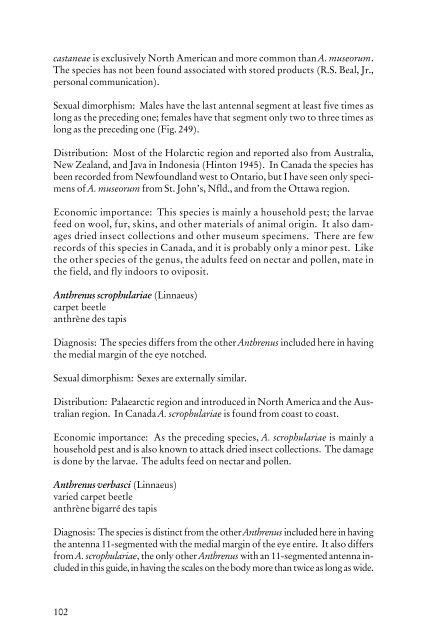Beetles Identification Guide
Beetles Identification Guide
Beetles Identification Guide
You also want an ePaper? Increase the reach of your titles
YUMPU automatically turns print PDFs into web optimized ePapers that Google loves.
castaneae is exclusively North American and more common than A. museorum.<br />
The species has not been found associated with stored products (R.S. Beal, Jr.,<br />
personal communication).<br />
Sexual dimorphism: Males have the last antennal segment at least five times as<br />
long as the preceding one; females have that segment only two to three times as<br />
long as the preceding one (Fig. 249).<br />
Distribution: Most of the Holarctic region and reported also from Australia,<br />
New Zealand, and Java in Indonesia (Hinton 1945). In Canada the species has<br />
been recorded from Newfoundland west to Ontario, but I have seen only specimens<br />
of A. museorum from St. John’s, Nfld., and from the Ottawa region.<br />
Economic importance: This species is mainly a household pest; the larvae<br />
feed on wool, fur, skins, and other materials of animal origin. It also damages<br />
dried insect collections and other museum specimens. There are few<br />
records of this species in Canada, and it is probably only a minor pest. Like<br />
the other species of the genus, the adults feed on nectar and pollen, mate in<br />
the field, and fly indoors to oviposit.<br />
Anthrenus scrophulariae (Linnaeus)<br />
carpet beetle<br />
anthrène des tapis<br />
Diagnosis: The species differs from the other Anthrenus included here in having<br />
the medial margin of the eye notched.<br />
Sexual dimorphism: Sexes are externally similar.<br />
Distribution: Palaearctic region and introduced in North America and the Australian<br />
region. In Canada A. scrophulariae is found from coast to coast.<br />
Economic importance: As the preceding species, A. scrophulariae is mainly a<br />
household pest and is also known to attack dried insect collections. The damage<br />
is done by the larvae. The adults feed on nectar and pollen.<br />
Anthrenus verbasci (Linnaeus)<br />
varied carpet beetle<br />
anthrène bigarré des tapis<br />
Diagnosis: The species is distinct from the other Anthrenus included here in having<br />
the antenna 11-segmented with the medial margin of the eye entire. It also differs<br />
from A. scrophulariae, the only other Anthrenus with an 11-segmented antenna included<br />
in this guide, in having the scales on the body more than twice as long as wide.<br />
102
















